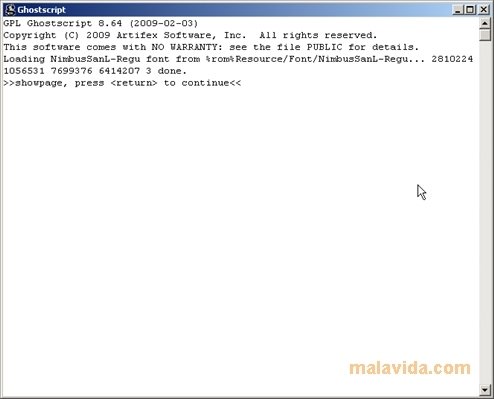- Ghostscript Download Windows
- Install Ghostscript Windows 10
- Ghostscript Viewer
- Install Ghostscript For Mac
- Avghostscript For Macbook Air
How I create an AppleScript script and application to map one or more network drives with username and password option. I have added examples and sample code at the bottom of this document. This is a Step-By-Step document created by Paul Luciano, MCSE
Trusted Windows (PC) download GNU Ghostscript 7.06. Virus-free and 100% clean download. Get GNU Ghostscript alternative downloads. How to acquire the development source code. The Ghostscript team use git for version control. If you require a snapshot of the development code, the easiest way to get it is to visit the web interface to our git repository: ghostpdl.git and click the 'snapshot' link next to the specific commit in which you are interested. Ghostscript, Gratis nedlasting av Artifex Software, Inc. This tool creates a PowerPoint file from a directory containing JPEG images.
8 Steps total

Step 1: Launching AppleScript app
) Open Finder
) Click Applications
) Expand Utilities
) Launch AppleScript Editor
) A blank AppleScript appears
Step 2: Creating the script
) Enter the code
) Click the Compile button to have AppleScript Editor check the code
) Fix any errors as needed
) Click the Run button to test the script
) Click File
) Click Save
) Enter a name for the script in the Save As: field
) Click the Save button
Ghostscript Download Windows
Step 3: Creating an app from the script
) Click File
) Click Save As...
) Change the File Format: field to Application
) Click the Save button
Step 4: Final results
As you can see by the image, you now have two (2) items to work with.
You can copy the app to other computers. The app is completely self-contained.
You can add the app to the Login Items for a user to make this a login script that launches at startup.
Step 5: Codelets for this script
Comment: --
Operator: mount volume
Volume Type: afp:// or smb://
User Name: [user name]
Password: [password]
Domain or Server: [domain];
Server: [server] or @[server]
Share: /[share]
Step 6: Samples of the correct syntax
mount volume 'smb://[domain];[username]:[password]@[server]/[share]'
mount volume “smb://[server]/[share]” as user name “[username]” with password “[password]”
mount volume “smb://[server]/[share]” (will require adding in ID/PW)
Step 7: Example information
Mac: MAC01
Mac Share: Recipies
Mac ID: sterling
Mac PW: archer
Windows Server: USFISE01
Windows Share: Marketing, Legal
Domain: Spiceworks
Domain ID: Importantguy
Domain PW: Iamlucky3
Install Ghostscript Windows 10

Ghostscript Viewer
Local Server ID: admin
Local Server PW: 123456

Step 8: Example code
mount volume “smb://spiceworks;Importantguy:Iamlucky3@USFISE01/legal”
mount volume “smb://MAC01/Recipies” as user name “sterling” with password “archer”
mount volume “smb://USFISE01;admin:123456@USFISE01/marketing”
Code was built and tested on a Mac Pro with Lion (OS X version 10.7.5) and an iMac with Yosemite (OS X version 10.10). AppleScript Editor version 2.4.3 (131.2); AppleScript 2.2.1.
Questions? Please feel free to contact me.
Paul Luciano, MCSE
Install Ghostscript For Mac

6 Comments
Avghostscript For Macbook Air
- DatilDavid_CSG Jan 21, 2015 at 10:21pm
How about the scripts themselves :-) ? Don't see them here.
Also your numbered lists are missing numbers (viewed in Firefox, Chrome and Safari) - DatilPaul Luciano Jan 22, 2015 at 03:13pm
David,
Thank you for your comments. The generic versions of the scripts I use are noted in Step 8. The script itself is really no more than one line of code. I just add an additional line for each share I want to mount. To translate into windows as a .BAT file:net use z: SERVERFSales /user:domain1admin pass1212
There may be more complicated parts you can add to do fancier things, but I just needed something simple.
I actually didn't add numbers to the lists, the steps become somewhat messy when I added numbers.
Regards,
Paul Luciano, MCSE
- JalapenoFerdinandthebull Jan 25, 2015 at 06:58pm
Thank you! This is very sexy stuff that I can put to use immediately at the office.
I was curious to see if the script code could handle a password with a space in it (since, on Macs, in Terminal, a space-as-character is handled by '/') and it did! - DatilPaul Luciano Jan 26, 2015 at 02:05pm
David,
I am glad the How To was helpful. Thank you for adding the information about the space as a character.
Regards,
Paul Luciano, MCSE - Pimientoemailya Apr 13, 2015 at 03:45am
Hello Paul,
Thank you for the helpful post..We have a Shared Common Drive that holds documents that students
need to access. We need to mount this drive onto the Macs, and then make it
stay when another user logs on. I did that using an admin account and its work well, but I can't see my drive when I login to Mac as student .
'Sounds simple right? Just use finder e.t.c ... however ! we have
students logging in under their own user name on the network... and then the
drive does not stay.
For example ... if Timmy01 logged in, and we mounted the drive
for Timmy, when Charlotte01 logged in she wouldnt have the drive, because its
not in her log-on items, its in Timmys...
What we need is a script that says ...
Mount 'x' Drive on log on, of any user.
Any ideas?'
Could you please help me out..
Thank you
- DatilPaul Luciano Oct 20, 2015 at 02:03pm
Emaily, Sorry for not getting back to you. I don't have an answer for your question. I did some research, but to no avail.
Regards,
Paul Luciano, MCSE